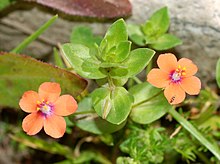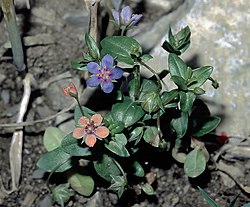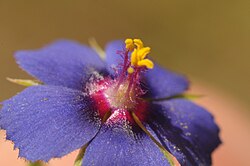
The Ericales are a large and diverse order of dicotyledons. Species in this order have considerable commercial importance including for tea, persimmon, blueberry, kiwifruit, Brazil nuts, argan, cranberry, sapote, and azalea. The order includes trees, bushes, lianas, and herbaceous plants. Together with ordinary autophytic plants, the Ericales include chlorophyll-deficient mycoheterotrophic plants and carnivorous plants.

The Primulaceae, commonly known as the primrose family, are a family of herbaceous and woody flowering plants including some favourite garden plants and wildflowers. Most are perennial though some species, such as scarlet pimpernel, are annuals.

Cyclamen is a genus of 23 species of perennial flowering plants in the family Primulaceae. In English, it is known by the common names sowbread or swinebread. Cyclamen species are native to Europe and the Mediterranean Basin east to the Caucasus and Iran, with one species in Somalia. They grow from tubers and are valued for their flowers with upswept petals and variably patterned leaves.

Lysimachia is a genus consisting of 182 accepted species of flowering plants traditionally classified in the family Primulaceae. Based on a molecular phylogenetic study it was transferred to the family Myrsinaceae, before this family was later merged into the Primulaceae.

Lysimachia nemorum, the yellow pimpernel, is a perennial flowering plant in the family Primulaceae.
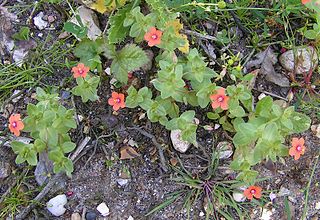
Anagallis is a genus of about 20–25 species of flowering plants in the family Primulaceae, commonly called pimpernel. The scarlet pimpernel referred to in literature is part of this genus. The botanical name is from the Greek ana and agállein, and it refers to the opening and closing of the flowers in response to environmental conditions.
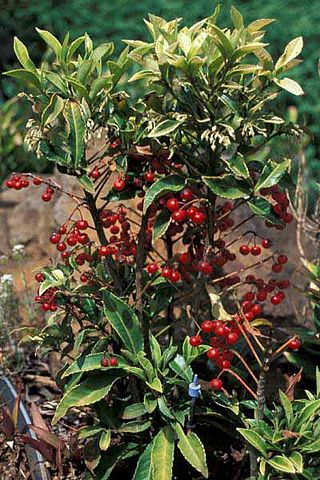
Myrsinoideae is a subfamily of the family Primulaceae in the order Ericales. It was formerly recognized as the family Myrsinaceae, or the myrsine family, consisting of 35 genera and about 1000 species. It is widespread in temperate to tropical climates extending north to Europe, Siberia, Japan, Mexico, and Florida, and south to New Zealand, South America, and South Africa.

The genus Anchusa belongs to the borage family (Boraginaceae). It includes about 35 species found growing in Europe, North Africa, South Africa and Western Asia. They are introduced in the United States.
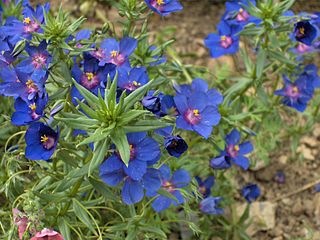
Lysimachia monelli, the blue pimpernel or garden pimpernel is a species of flowering plant in the family Primulaceae, native to the Mediterranean region. It is not to be confused with Lysimachia foemina, which has very similar blue flowers, but broader leaves and can be found also in colder climates. In a comparison of DNA sequences, L. monelli was shown to be most closely related to L. foemina. The latter had been thought by many to be closest to L. arvensis, and some authors had even included L. foemina as a subspecies of L. arvensis. The three species were among several transferred from Anagallis to Lysimachia in a 2009 paper.

Lysimachia maritima is a plant species belonging to the family Primulaceae. It was previously called Glaux maritima, the only species in the monotypic genus Glaux. The species has a number of common names, including sea milkwort, sea milkweed, and black saltwort.

Lysimachia vulgaris, the yellow loosestrife or garden loosestrife, is a species of herbaceous perennial flowering plant in the family Primulaceae. It was transferred to Myrsinoideae based on results of molecular phylogenetic research before being merged into the Primulaceae.
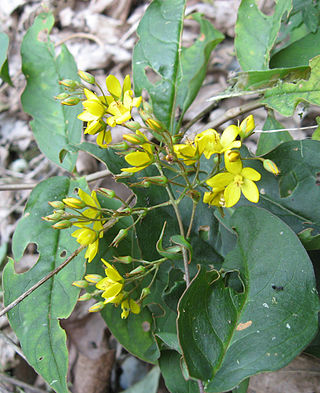
Lysimachia fraseri is a rare species of flowering plant in the primrose family known by the common name Fraser's yellow loosestrife. It is native to the Southeastern United States, where it is listed as an endangered species in several states.
Arvensis, a Latin adjective meaning in the fields, is the specific epithet of the following:
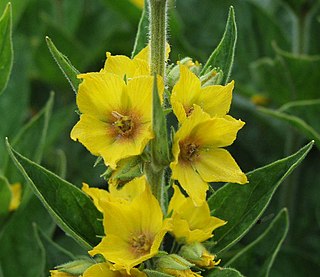
Lysimachia punctata, the dotted loosestrife, large yellow loosestrife, circle flower, or spotted loosestrife, is a flowering plant species in the family Primulaceae.
Lysimachia pendens is a rare species of flowering plant in the family Primulaceae known by the common name broad-leaf yellow loosestrife. It is endemic to Hawaii, where there is a single occurrence known on the island of Kauai. It was federally listed as an endangered species of the United States in 2010.
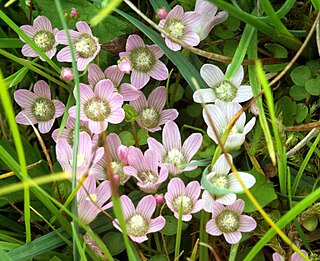
Anagallis tenella, known in Britain as the bog pimpernel, is a low growing perennial plant found in a variety of damp habitats from calcareous dune slacks to boggy and peaty heaths in Eurasia. In the United Kingdom it is mostly restricted to the western half of the country, although it was more common in the east before land drainage and intensification of farming in that area.

Lysimachia foemina is commonly known as blue pimpernel or poor man's weatherglass, and was formerly called Anagallis foemina. It is a low-growing annual herbaceous plant in the genus Lysimachia of the family Primulaceae. In a comparison of DNA sequences, L. foemina was shown to be most closely related to L. monelli. It had been thought by many to be closest to L. arvensis, and some authors had even included L. foemina as a subspecies of L. arvensis, as Anagallis arvensis subsp foemina. These three species were among several transferred from Anagallis to Lysimachia in a 2009 paper.
Blue pimpernel is a common name for several plants and may refer to:

Lysimachia clethroides, the gooseneck loosestrife, is a species of flowering plant, traditionally classified in the family Primulaceae. It was transferred to the family Myrsinaceae based on a molecular phylogenetic study, but this family was later merged into the Primulaceae.
